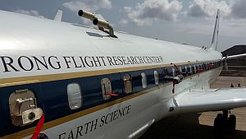Atmospheric scientists of NASA and MPI for Biogeochemistry meet at Ascension Island

A NASA research aircraft took a stopover on Ascension Island. On board the almost 45-year-old aircraft was a team of about 40 scientists and crew along. They brought more than 20 instruments to measure the concentrations of aerosols, greenhouse gases and air pollutants in the atmosphere.
NASA's Atmospheric Tomography Mission (ATom) mission is led by Harvard University scientist Steve Wofsy, well known at the institute as member of the Scientific Advisory Board. This mission's goal is to take a complete inventory of the state of Earth's atmosphere. During several flights between the northern and southern Polar Regions, the aircraft takes atmospheric profiles between 200 m and 12 km altitude. During the course of 4 years, large parts of the globe as well as all seasons should be covered.
Ascension Island was a special stop. On this remote island in the South Atlantic Ocean, the Max Planck Institute for Biogeochemistry runs a station of the Total Carbon Column Observing Networks (TCCON). For more than 4 years, this station has been observing the concentrations of major greenhouse gases. It is the only station in the Atlantic sector that covers the equatorial region. Being able to compare airborne and ground based measurements is a rare and valuable opportunity. To make sure that everything is running, the institute’s team went to Ascension Island one week before the NASA aircraft arrived. Luckily, the weather was fine, too, as the ground measurements depend on sunlight.
The air/ground intercomparisons should be continued. The next visit of the NASA DC-8 is already planned for February 2017.












